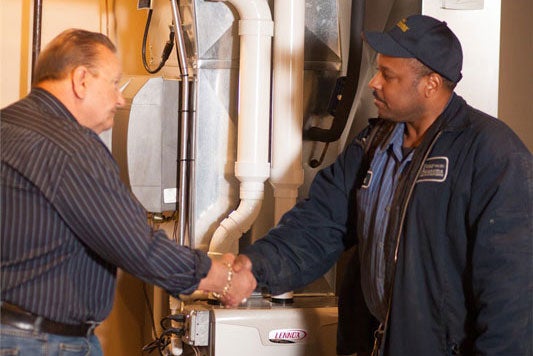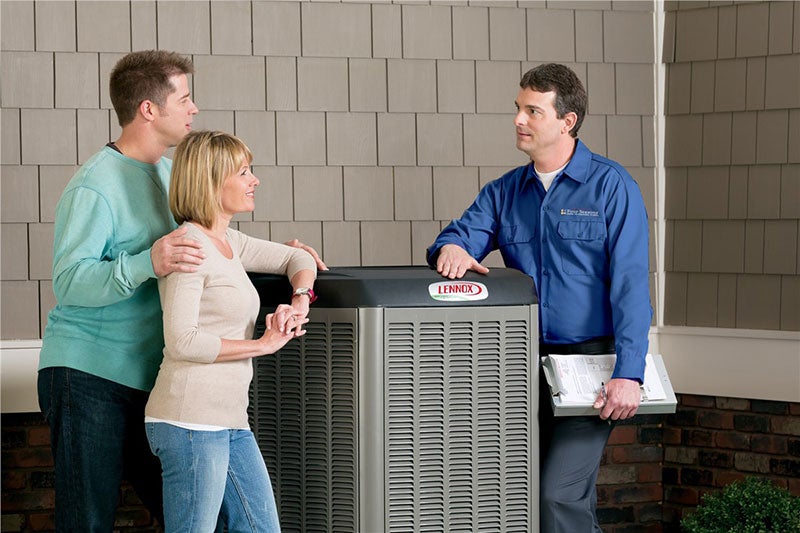CALL YOUR TRUSTED LOCAL EXPERTSSM
What is Forced Air Heating and Air Conditioning?
By Dave Musial: CEO of Four Seasons Heating, Air Conditioning, Plumbing, Electric.
- September 17, 2025
If you’re using a thermostat to change the temperature in your home to have warm or cool air, you have a forced air heating system. It’s one of the most common types of heating systems in Chicago homes. You’ve probably heard of the term forced air, but what does it actually mean?
What is Forced Air Heating?
Forced air heating uses a furnace (gas, electric, or oil) to heat air by moving it over a heating element. That warm air is then “forced” through ducts and vents into the rooms of your home. This process continues until the temperature set on your thermostat is reached. Unlike radiant heating or baseboard systems, forced air moves heat quickly, creating even distribution throughout your home.
Every component of your furnace—blower motor, heating element, thermostat, and duct system—must work together to maintain that comfort. If even one part isn’t working properly, your system may struggle. That’s why regular furnace maintenance and tune-ups are so important. Scheduling service ensures every component is operating efficiently, extending the life of your system and keeping energy bills under control.
You can usually tell if you have a forced air heating system if your home has:
- Floor or wall vents where warm air blows out
- A thermostat that controls a furnace or HVAC system
- A network of ducts behind walls and ceilings carrying air throughout your home

What About Forced Air Conditioning?
The same ductwork that delivers heat in winter can also deliver cool air in summer. In this case, the system includes a central air conditioner or a heat pump that chills the air and sends it through the ducts. This is why people often use the term forced air to describe both heating and cooling—it’s the same delivery method.
Here’s how forced air cooling works:
- The air conditioner or heat pump cools the air by removing heat and humidity.
- A blower fan pushes the cooled air through the ductwork.
- Vents in each room release the air, lowering temperatures evenly.
- Warmer air is pulled back through return ducts, creating a continuous cycle.
Because it uses ducts, forced air AC cools the entire home efficiently—unlike window or ductless systems that only cover individual rooms. Plus, filters improve indoor air quality by reducing dust, pollen, and allergens while the system runs.

Forced Air vs Central Air: What’s the Difference?
A common question homeowners ask is: Is forced air the same as central air? The two are related, but not identical:
- Forced Air: Refers to the method of moving heated or cooled air through ducts using a blower fan. It applies to both furnaces (heating) and AC/heat pumps (cooling).
- Central Air: Refers specifically to a cooling system—typically a central air conditioner—that delivers cold air through ducts.
Think of it this way: forced air is the method, central air is one type of system that uses that method.
For Chicago homeowners with existing forced air heating, the good news is you already have the ductwork in place for central AC. Adding an air conditioning unit is typically much easier and more cost-effective than installing an entirely new system.
Why Choose Forced Air Heating and Cooling?
There are several benefits to using a forced air system:
- Efficiency: Modern furnaces and air conditioners are designed to work seamlessly with forced air systems, delivering high energy efficiency. With programmable thermostats and variable-speed blower motors, they can adjust output to use only as much energy as needed, helping reduce monthly utility bills.
- Comfort: Warm or cool air is distributed quickly and evenly throughout the home. That means fewer hot or cold spots and a more consistent indoor temperature, even during extreme Chicago winters or humid summers.
- Air Quality: Forced air systems can significantly improve indoor air quality. They use replaceable or upgradeable filters that capture dust, pollen, pet dander, and other allergens. You can also add humidifiers, dehumidifiers, or air cleaners to the ductwork, creating a healthier living environment for your family.
- Dual Purpose: One duct system does double duty—handling both heating in the winter and cooling in the summer. This saves space compared to installing separate systems, making it ideal for urban homes where square footage is limited.
- Flexibility: Because the system uses ducts, it can easily be paired with modern upgrades like smart thermostats, zoning systems, and even whole-home ventilation. This gives homeowners more control over comfort and energy usage.
- Resale Value: Buyers often look for homes with forced air systems because they are versatile, reliable, and easy to maintain. Having one in place can increase your home’s value and make it more appealing on the market.

Are There Any Drawbacks to Forced Air Systems?
While forced air heating and cooling is one of the most popular and practical choices for homeowners, it’s worth noting a few potential drawbacks:
- Noise: Some older systems or poorly maintained units can produce noticeable noise from the blower or ducts when running.
- Air Loss: If ducts aren’t sealed properly, air can leak out, reducing efficiency and raising energy bills.
- Dust & Allergens: Because air is constantly moving through ducts, dust and allergens can circulate if filters aren’t changed regularly or ducts aren’t cleaned.
- Space Requirements: Ductwork takes up space in walls, ceilings, and basements, which may not be ideal for very small or older homes that weren’t built with ducts in mind.
These issues are usually manageable with regular maintenance or system replacements. In fact, many modern systems are designed to minimize noise, improve filtration, and maximize efficiency.
Stay Comfortable with Four Seasons Heating, Air Conditioning, Plumbing & Electric
Forced air heating and air conditioning remain one of the most versatile, efficient, and common HVAC options for homeowners in Chicago. From consistent comfort to improved indoor air quality and long-term value, these systems are built to handle both heating and cooling needs in one setup.
If you’re experiencing issues with your home’s heating or cooling system—or if you’re ready to add air conditioning to your forced air setup Four Seasons is here to help with expert service, repairs, and installations.


